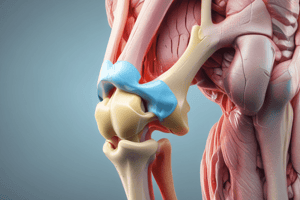Podcast
Questions and Answers
Which ligament tear is most likely to occur with a valgus force applied to the knee?
Which ligament tear is most likely to occur with a valgus force applied to the knee?
- LCL tear
- PCL tear
- MCL tear (correct)
- ACL tear
Which ligament tear is most likely to occur with a valgus force and rotation applied to the knee?
Which ligament tear is most likely to occur with a valgus force and rotation applied to the knee?
- LCL tear
- ACL tear
- MCL tear
- PCL tear (correct)
Which ligament tear is most likely to occur with a valgus force, rotation, and weight bearing applied to the knee?
Which ligament tear is most likely to occur with a valgus force, rotation, and weight bearing applied to the knee?
- MCL tear
- ACL tear
- Medial meniscus tear (correct)
- PCL tear
Which ligament tear is most likely to occur with a varus force applied to the knee?
Which ligament tear is most likely to occur with a varus force applied to the knee?
Which ligament tear is most likely to occur with a varus force and rotation applied to the knee?
Which ligament tear is most likely to occur with a varus force and rotation applied to the knee?
Which ligament tear is most likely to occur with a dashboard injury?
Which ligament tear is most likely to occur with a dashboard injury?
Which ligament tear is most likely to occur with a posterior sag in the anteroposterior stability test?
Which ligament tear is most likely to occur with a posterior sag in the anteroposterior stability test?
Which ligament tear is most likely to be diagnosed using the anterior drawer test?
Which ligament tear is most likely to be diagnosed using the anterior drawer test?
Which ligament tear is most likely to be diagnosed using the Lachman test?
Which ligament tear is most likely to be diagnosed using the Lachman test?
What is the most common presentation of an ACL tear?
What is the most common presentation of an ACL tear?
Which test is used to assess for anteroposterior glide in the knee?
Which test is used to assess for anteroposterior glide in the knee?
What does a posterior sag sign indicate?
What does a posterior sag sign indicate?
Which imaging technique is used to differentiate partial from complete tear?
Which imaging technique is used to differentiate partial from complete tear?
What is the initial treatment for a partial tear?
What is the initial treatment for a partial tear?
What is the initial treatment for a complete MCL or LCL tear?
What is the initial treatment for a complete MCL or LCL tear?
What is the initial treatment for a complete ACL or PCL tear?
What is the initial treatment for a complete ACL or PCL tear?
What is the initial treatment for a combined collateral ligament tear and ACL or PCL tear?
What is the initial treatment for a combined collateral ligament tear and ACL or PCL tear?
When should avulsion injuries be surgically treated?
When should avulsion injuries be surgically treated?
What is the purpose of an arthroscopy in the management of ACL tear?
What is the purpose of an arthroscopy in the management of ACL tear?
At what position should the hip and knee be during the posterior sag sign test?
At what position should the hip and knee be during the posterior sag sign test?
Flashcards are hidden until you start studying
Study Notes
Ligament Tears and Forces
- A valgus force applied to the knee is most likely to cause a medial collateral ligament (MCL) tear.
- A valgus force with rotation applied to the knee is most likely to cause an ACL (anterior cruciate ligament) tear.
- A valgus force, rotation, and weight bearing applied to the knee is most likely to cause an ACL and MCL tear.
- A varus force applied to the knee is most likely to cause a lateral collateral ligament (LCL) tear.
- A varus force with rotation applied to the knee is most likely to cause an LCL and posterior cruciate ligament (PCL) tear.
Diagnostic Tests and Imaging
- The anterior drawer test is used to diagnose ACL tears.
- The Lachman test is used to diagnose ACL tears.
- The posterior sag sign indicates a posterior cruciate ligament (PCL) tear.
- The Lachman test is used to assess for anteroposterior glide in the knee.
- MRI is used to differentiate partial from complete tears.
Treatment and Management
- The initial treatment for a partial tear is conservative management.
- The initial treatment for a complete MCL or LCL tear is surgical reconstruction.
- The initial treatment for a complete ACL or PCL tear is surgical reconstruction.
- The initial treatment for a combined collateral ligament tear and ACL or PCL tear is surgical reconstruction.
- Avulsion injuries should be surgically treated if they are displaced or involve a large fragment of bone.
- Arthroscopy is used to assess the extent of an ACL tear and perform surgical reconstruction.
Examination Techniques
- The posterior sag sign test is performed with the hip and knee in 90 degrees of flexion.
Studying That Suits You
Use AI to generate personalized quizzes and flashcards to suit your learning preferences.




